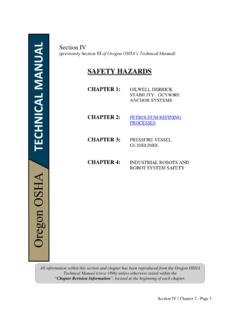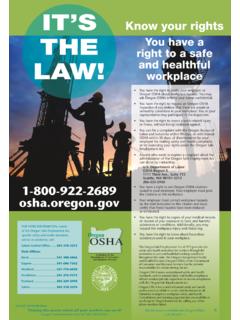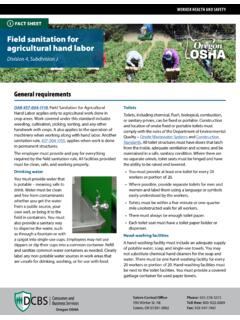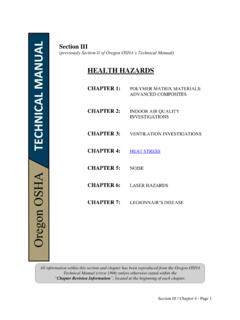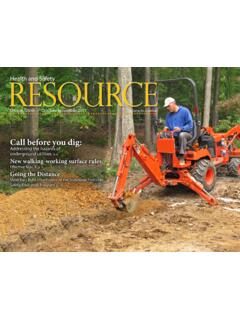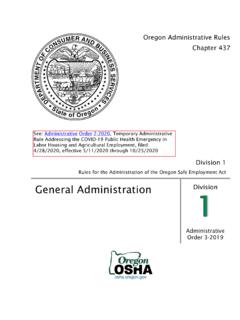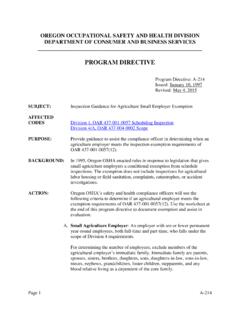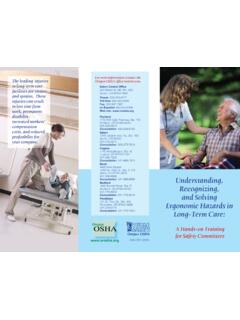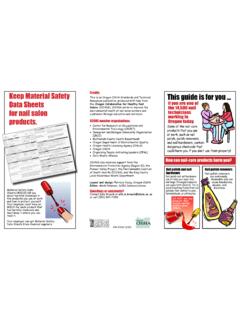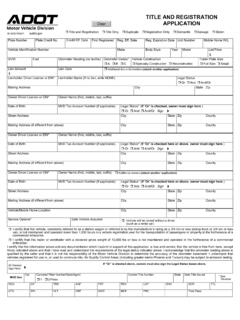Transcription of Fall Protection for Construction Activities - Oregon
1 WORKER HEALTH AND SAFETYFall Protection for Construction activitiesOregon OSHAA bout this guideFall Protection for Construction Activities is an Oregon OSHA Standards and Technical Resources publication. Who should read this guide?This guide is for anyone who wants to understand fall Protection concepts and best practices when performing Construction Activities . It s also for those who don t have a professional background in fall Protection systems and who want to understand the requirements in Division 3, Subdivision M, Fall Protection . The guide also highlights fall Protection requirements for work on ladders and the guide is organized Parts one and two describe what to consider before on-site work begins.
2 Part three describes how to identify and evaluate fall hazards essential fall Protection Activities . Parts four and five describe how to get safely to the work area. Part six describes fall Protection systems, methods, and the requirements for using them. Parts seven, eight, and nine cover fall Protection training, equipment maintenance, and emergency noticePrinting, excerpting, or plagiarizing this publication is fine with us as long as it s not for profit! Please inform Oregon OSHA of your intention as a compliance with the Americans with Disabilities Act (ADA), this publication is available in alternative formats. Call Oregon OSHA, 503-378 Protection for Construction activitiesContentsAbout this guide.
3 2 Introduction .. 6 What is fall Protection ? .. 6 Why we need Protection from falling .. 7 What is your fall Protection role? .. 7 Part one Falling: truths and consequences .. 9 How Oregon Construction workers fall .. 10 Falls in Oregon .. 11 Part two Preparing to prevent falls .. 13 Make fall Protection part of your safety program .. 14 Prepare a safety policy .. 14 Designate competent persons and qualified persons .. 15 Duties and responsibilities of competent and qualified persons .. 16 Summary: Preparing to prevent falls .. 17 Part three Identifying and evaluating fall hazards ..19 What is a fall hazard?
4 20 How to evaluate fall hazards ..20 Fall Protection trigger heights for Construction ..23 Summary: Evaluating fall hazards .. 244 Fall Protection for Construction activitiesPart four Supported access .. 27 What is supported access? .. 28 Portable ladders ..28 Supported scaffolds .. 30 Aerial lifts .. 34 Part five Suspended access .. 37 What is suspended access? .. 38 Adjustable-suspension scaffolds .. 38 Crane- and derrick-suspended personnel platforms .. 43 Part six Preventing and controlling falls ..45 What is a fall Protection system? .. 46 What to consider when selecting a fall Protection system.
5 47 Personal fall-arrest systems .. 48 Personal fall-restraint systems .. 53 Positioning-device systems .. 53 Guardrail systems .. 54 Safety-net systems .. 56 Warning line systems for roofing work .. 57 Safety monitoring for roofing work .. 59 Catch platforms .. 59 Covers for holes ..60 Fences and barricades ..60 Protecting workers from falling objects .. 61 Warning lines for non-roofing Construction acitivities .. 585 Fall Protection for Construction activitiesPart seven Training workers about fall Protection .. 63 Why train workers about fall Protection ? ..64 Employers: Your responsibility .. 64 Required training for workers exposed to fall hazards.
6 64 Part eight Maintaining equipment .. 67 Inspecting equipment .. 68 Summary: Inspecting, cleaning, and storing equipment ..70 Part nine Responding to falls ..73 Prompt rescue required .. 74 Developing an emergency-response plan .. 74 Summary: Responding to falls .. 76 Appendix An overview of Subdivision M .. 79 About Subdivision M .. 80 Scope, application, and definitions .. 80 Duty to have fall Protection .. 80 Fall Protection systems, criteria, and practices .. 81 Training requirements .. 826 Fall Protection for Construction activitiesIntroductionFalls from heights contribute to more deaths in Construction than any other hazard.
7 A fall can occur in a split second without any time for the worker to react. Using fall Protection can mean the difference between life and is fall Protection ?Ask 10 people what fall Protection means and you are likely to get 10 different answers. For many in the Construction industry, equipment is the first thing that comes to mind: guardrails, personal fall Protection systems, or safety nets, for example. But fall Protection is more than equipment. Fall Protection is also what you do to eliminate fall hazards, to prevent falls, and to ensure that workers who do fall don t accomplish fall Protection by doing the following: Ensure that everyone has a role to play in preventing falls.
8 Identify and evaluate fall hazards. Eliminate fall hazards, whenever possible, rather than using personal fall protect systems. Train workers to recognize fall hazards and how to protect themselves. Use appropriate systems and methods to prevent falls and to protect workers if they do fall. Inspect and maintain fall Protection equipment before and after using it. Become familiar with Oregon OSHA s fall Protection Protection for Construction activitiesWhy we need Protection from fallingWe need Protection because even if we are experienced with working at heights, we can still lose our balance or grip. We can slip, trip, or misstep, and fall at any time.
9 We may think that our reflexes will protect us, but we can fall before we have time to react. And we don t have to fall far to get hurt. What is your fall Protection role?Everyone involved in a Construction project has a role to play in preventing : Prevent falls by planning to safely get the job done, providing the right fall Protection equipment, and training all workers to use the equipment safely. Employees: Follow safe work practices, properly use fall Protection equipment and participate in training. Recognize fall hazards and unsafe practices, know the jobs that increase the risk of falling, and understand how to eliminate and control exposures to fall contractors: Take reasonable steps to provide for frequent and regular inspections of the jobsite to identify hazards and to eliminate or control employee exposure to them, including fall hazards.
10 Architects and engineers: Educate employers about hazards that could expose workers to falls during each phase of a Construction project. When designing buildings and structures, consider fall Protection and other safety needs for those who will do the Construction work and those who will eventually need to perform owners and managers: Ensure that those who do exterior Construction or maintenance work know how to protect themselves from falls, are aware of the location of installed anchorages, and know how to use their fall Protection equipment. Maintain engineering documentation on permanently installed anchors for future manufacturers: Ensure that fall Protection equipment meets OSHA and American National Standards Institute (ANSI) safety requirements and protects workers when they properly use it.

